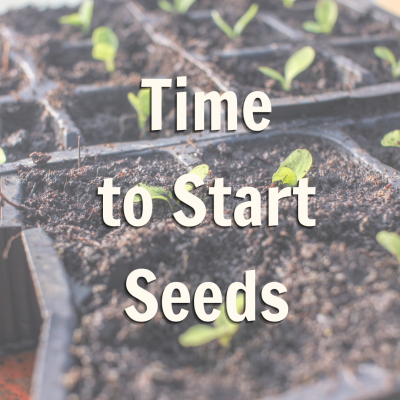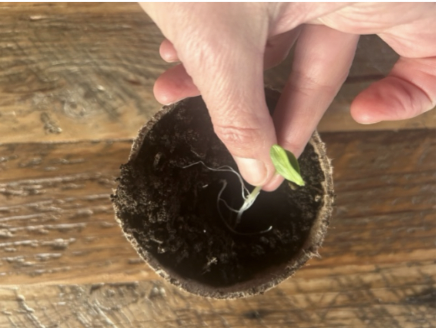
Outdoor garden season is just around the corner. Late February is the perfect time to start growing seeds indoors, especially if you live in the Willamette Valley and Coastal Regions. Starting seeds indoors gives you a head start on the growing season. It’s especially helpful when you’re growing plants that need extra time, like tomatoes and peppers. After starting these seeds indoors, you will need to wait at least 6 to 8 weeks before planting outside so that all risk for frost has passed. To get started with growing tomatoes, peppers and other garden veggies, check out Food Hero’s Gardening Calendar.
Update from the Food Hero Test Garden
Wondering what is happening in the Food Hero test garden at Philomath Elementary School this month? Our garden coordinator Tyler Sato Spofford has an exciting update with more winter garden ideas. “Hello from the Philomath School Garden! We did some great planning in January and have our seeds all organized. We are going to build some trellis supports for our tomatoes, beans, peas and new garden forts! Last year we used bamboo as a quick and inexpensive option for the garden. They are still standing but will likely not make it through another season. This year we are upgrading to metal that will last a long time. At the end of the month, we will plant lettuce, radishes, carrots, spinach, chard and broccoli.”
Wondering when you can plant the same cold weather crops in your area? Or want to know more about what seeds to start indoors? Food Hero’s Oregon Garden Planner can help! Just select your growing region and vegetable to learn more about when and how to get started.
Questions About Seeds
As you plan your seed-starting and planting activities, you may have questions. Food Hero is here to help! With our Grow This! Oregon Garden Challenge underway, we’ve been answering questions from participants. You might find this information helpful, too!
Question: What is the best way to store seeds?
Answer: Seeds can begin to grow when they have water. They can even get this water from the air! This is why it is important to store seeds in airtight containers. Light and heat can also spoil seeds. A cool, dark place is best for storing seeds.
Question: Are the seeds I have from last year still good?
Answer: As seeds age, fewer will be able to sprout into a plant (or germinate). In other words, their germination rate will go down. Some types of seeds will be good for only one or two years, while others can last over five years. This handy chart shows how long different types of seeds will last in airtight containers.
| Average Number of Years Seeds Will Last | 1 to 2 years | 3 years | 4 years | 5 years or more |
| Types of Veggies | Onion, okra, pepper, corn, leek, parsnip, parsley | Asparagus, green beans, broccoli, carrot, celery, kohlrabi, peas, spinach | Beets, Brussel sprouts, cabbage, cauliflower, chard, eggplant, fennel, kale, mustard greens, pumpkin, rutabaga, squash, tomato, turnip, watermelon | Collards, cucumber, lettuce, radish |
If you are not sure how old your seeds are, there is an easy way to test your seeds to see if they will still grow into plants.
Materials needed:
- 1 damp paper towel
- 1 zip-top bag
- 10 seeds from the packet you're testing
Instructions:
- Place the 10 seeds, spaced apart, on one half of the damp paper towel.
- Fold the paper towel in half to cover all the seeds.
- Place the paper towel in a zip-top bag.
- Place the zip-top bag in a warm location with light.
- Wait until the seeds begin to sprout. How long they'll take is their days to germination. You'll find this on the seed packet. *During that time, check and make sure the paper towel does not dry out.
*If you no longer have the seed packet, check out Food Hero's seed packet information for help.


Count how many seeds germinated or started to grow. You will see a little white or green shoot starting to sprout from the seed.
- If 8 or more seeds sprouted, then put one seed in each hole when you plant them.
- If 5 to 7 seeds sprouted, then plant two or three seeds in each hole. This will make it more likely that a plant will grow.
- Another option is to grow microgreens. This is a good option if 6 or fewer seeds sprouted. Read more about microgreens here: https://foodhero.org/microgreens
- Don’t forget to plant the seeds that sprouted during your paper towel test!

To learn more about storing, saving and testing seeds, visit our garden-tips sheets: Seed-Saving Tips for Success and Will Your Seeds Grow Plants?
Cold Weather Recipes for Seasonal Veggies
Are all these ideas about growing veggies inspiring you to cook some? Green onions, kale, rutabaga, garlic, winter squash and chard are all in season. You can find locally grown varieties in grocery stores and some farmers markets. Try them in our delicious Food Hero recipes!
- Butternut Apple Crisp: Savory butternut squash and tart apples are topped with cinnamon and oat crumbles to make this delicious and colorful dessert!
- Kale and White Bean Soup: Looking for a warm, filling soup to cozy up with? Give this one a try! It’s the perfect blend of beans, greens and Italian flavors.
- Cheesy Beef Pasta: This kid-approved recipe can be made in under an hour! Garlic, basil, and oregano give this dish a boost of flavor. Try adding chard or kale for a boost of veggies!
- Peanutty Stew: Top this hearty stew with green onions and chopped peanuts to add a flavorful crunch!
We hope you enjoy these recipes. Good luck with your seed-starting!




